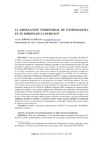Identificador persistente para citar o vincular este elemento:
https://accedacris.ulpgc.es/handle/10553/114450
| Campo DC | Valor | idioma |
|---|---|---|
| dc.contributor.author | Jiménez Barrado, Victor | en_US |
| dc.date.accessioned | 2022-04-27T14:43:04Z | - |
| dc.date.available | 2022-04-27T14:43:04Z | - |
| dc.date.issued | 2017 | en_US |
| dc.identifier.issn | 2444-0272 | en_US |
| dc.identifier.uri | https://accedacris.ulpgc.es/handle/10553/114450 | - |
| dc.description.abstract | Desde la creación de la Eurorregión Alentejo-Centro-Extremadura (EUROACE) en 2009, la ordenación territorial de la Comunidad Autónoma extremeña debe considerar un nuevo marco espacial inmediato de relaciones socioeconómicas más amplio y a escala transnacional. Las políticas europeas de cooperación territorial, iniciadas en las postrimerías del siglo XX, han permitido la aparición de sinergias que, hasta entonces, las fronteras nacionales habían impedido. La Iniciativa INTERREG es, sin duda, el pilar fundamental de esta colaboración entre las regiones de los países comunitarios, que con los cinco periodos de programación existentes cumplirá tres décadas. En este nuevo contexto, la región extremeña aprobó la Ley 15/2001, de 14 de diciembre, del Suelo y Ordenación Territorial de Extremadura (LSOTEX), aunque su aplicación íntegra y efectiva no ha tenido lugar. La coherencia de un modelo teórico de planificación territorial prevalente sobre la ordenación urbanística no se ha traspuesto a la realidad. El problema radica no sólo en el exiguo ritmo de aprobación de los instrumentos de planeamiento, sino también en la aparición de éstos fuera de una secuencia espacial y temporal lógica. De esta forma, la ordenación del territorio extremeño comenzó por los Proyectos de Interés Regional (PIR), empleados de manera aislada, aunque muy prolífica, y con mayores implicaciones urbanísticas que territoriales. Posteriormente, la aprobación de Planes Territoriales (PT) ha resultado escasa y descoordinada por la ausencia del modelo territorial que las inéditas Directrices de Ordenación Territorial (DOT) deben proponer. Por lo tanto, Extremadura tiene que explorar caminos diferentes en este ámbito, que muy posiblemente signifiquen desandar lo recorrido y constituir un nuevo cuerpo legal que garantice la congruencia territorial a través de sus instrumentos de planeamiento y contemple su integración en un escenario de relaciones transfronterizas. | en_US |
| dc.description.abstract | Since the establishment of the Alentejo-Centre-Estremadura Euroregion (EUROACE) in 2009, spatial planning of the Autonomous Community of Estremadura should consider a new immediate spatial framework of wider socio-economic relations and transnational scale. European territorial cooperation policies, begun in the late twentieth century, have allowed the emergence of synergies which, until then, had prevented by national borders. The INTERREG Initiative is, undoubtedly, the key element of this collaboration between the regions of the European Union countries, which will make three decades with the five existing programming periods. In this new context, Estremadura adopted the Law 15/2001, of December 14th, of Spatial Planning and Land of Estremadura (LSOTEX), although its full and effective implementation has not taken place. The consistency of a theoretical model of prevalent land use planning on the urban planning has not been transposed into reality. The problem lies not only in the meager pace of approval of planning instruments, but also in the appearance of these out of a spatial and temporal logical sequence. Thus, frontier territory management began by Regional Interest Projects (RIP), used in isolation, although in very prolific way, and with more urban implications than territorials. Subsequently, the approval of Territorial Plans (TP) has been scarce and uncoordinated by the absence of territorial model, that unpublished Regional Planning Guidelines (RPG) should be proposed. Therefore, Estremadura has to explore different paths in this area, quite possibly means retrace his route and establish a new body of law that guarantees the territorial congruity through their planning tools and considers their integration in a cross-border relations context. | en_US |
| dc.language | spa | en_US |
| dc.relation.ispartof | Polígonos | en_US |
| dc.source | Polígonos: Revista de Geografía [2444-0272], nº 29, p. 269-300 | en_US |
| dc.subject.other | Cooperación Transfronteriza | en_US |
| dc.subject.other | EUROACE | en_US |
| dc.subject.other | Extremadura | en_US |
| dc.subject.other | INTERREG | en_US |
| dc.subject.other | Ordenación Territorial | en_US |
| dc.subject.other | Cross-Border Cooperation | en_US |
| dc.subject.other | Spatial Planning | en_US |
| dc.title | La ordenación territorial de Extremadura en el ámbito de la EUROACE | en_US |
| dc.title.alternative | Spatial planning of Estremadura in the field of EUROACE | en_US |
| dc.type | info:eu-repo/semantics/article | en_US |
| dc.type | Article | en_US |
| dc.identifier.doi | 10.18002/pol.v0i29.5209 | en_US |
| dc.description.lastpage | 300 | en_US |
| dc.description.firstpage | 269 | en_US |
| dc.investigacion | Artes y Humanidades | en_US |
| dc.type2 | Artículo | en_US |
| dc.utils.revision | Sí | en_US |
| dc.identifier.ulpgc | No | en_US |
| dc.contributor.buulpgc | BU-HUM | en_US |
| dc.description.dialnetimpact | 0,0 | |
| dc.description.dialnetq | Q2 | |
| dc.description.dialnetd | D5 | |
| item.grantfulltext | open | - |
| item.fulltext | Con texto completo | - |
| crisitem.author.dept | GIR IATEXT: Sociedades y Espacios Atlánticos | - |
| crisitem.author.dept | IU de Análisis y Aplicaciones Textuales | - |
| crisitem.author.dept | Departamento de Geografía | - |
| crisitem.author.orcid | 0000-0001-7064-7465 | - |
| crisitem.author.parentorg | IU de Análisis y Aplicaciones Textuales | - |
| crisitem.author.fullName | Jiménez Barrado, Victor | - |
| Colección: | Artículos | |
Visitas
95
actualizado el 01-mar-2025
Descargas
37
actualizado el 01-mar-2025
Google ScholarTM
Verifica
Altmetric
Comparte
Exporta metadatos
Los elementos en ULPGC accedaCRIS están protegidos por derechos de autor con todos los derechos reservados, a menos que se indique lo contrario.
